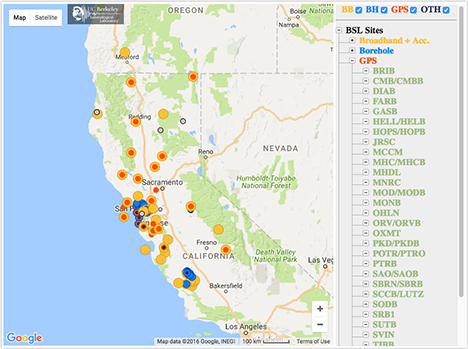Electromagnetic Field Measurements


In collaboration with Professor Frank Morrison of the Department of Civil and Environment Engineering, the Berkeley Seismological Laboratory has established electromagnetic field observatories at 2 BDSN sites.
Sites were initially established at SAO and PKD1. When the BDSN site at PKD1 was relocated to PKD, additional electromagnetic sensors were installed there. The PKD1 equipment was recorded in parallel with PKD for several months and then removed in early 1999.
In addition, the BSL collaborates with Professor Steve Park of UC Riverside to collect and archive data from a low-frequency, long-baseline electric field project at site PKD2. This experiment (which is separate from the observatory at site PKD1), uses an 8 channel Quanterra datalogger to record the data.
- Network Code
-
BK
- Current Station Equipment
-
3-component magnetic field sensors (0.0001 - 20 Hz)
Multiple component electric field sensors (DC - 20 Hz)
24-bit Quanterra digital data logger
GPS clock
Continuous telemetry to UC Berkeley
Dialup telephone access
72 hour backup power supply - Recorded Channels
-
Sensor SEED Channels Rate (samples/sec) Sampling Mode FIR Filter Magnetic VT? 0.1 Continuous Acausal Magnetic LT? 1.0 Continuous Acausal Magnetic BT? 40.0 Continuous Acausal Electric VQ? 0.1 Continuous Acausal Electric LQ? 1.0 Continuous Acausal Electric BQ? 40.0 Continuous Acausal - Network State of Health
-
The BSL has been working with Dr. Gary Egbert at
Oregon State University to install his software
for automated data processing and quality control.
Characteristics of integrated spectra and parameters of the first Earth-ionosphere cavity resonance are calculated routinely.
- Station and Channel Information
-
- Map of BDSN stations
- Table of BDSN stations
- BK Information Directory, including
- List of station locations
- List of available channels
- Instrument Response
- Information on Quanterra Timing Errors
- Data access
-
Waveform data from the BK network are available in
SEED format.
Several tools provide access to SEED format data at the
NCEDC, both in terms of querying the archives and
allowing data requests.
- Querying the archives
- Requesting data
Help on using these tools is available.
The results of daily magnetic activity and Schumann resonance are available at the NCEDC. The README file provides some additional information.
- Reports and Publications
-
- Reports on the Electromagnetic observatories from the Annual Report of the BSL:
- Collaborations
-
The electromagnetic observatories were initiated as a
cooperative project with UC Riverside and Stanford University with
funding from the USGS NEHRP.
